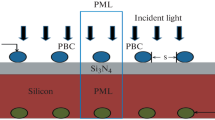Abstract
Significant enhancement of radiative efficiency of thin-film silicon light-emitting diodes achieved by placing the active layer in close proximity to silver (Ag) nanoparticles has been observed. In this paper, optical properties including transmission, reflection, and absorption of a random assembly of Ag nanoparticles are theoretically investigated using the effective medium model. Furthermore, the influence of Ag nanoparticles on light emission of silicon light-emitting diodes is studied by an improved effective mode volume model we propose here. The normalized line shape of dipole oscillation is calculated directly using Lorentz–Drude model without using any approximation. Thus, it results in more accurate calculation of the enhanced Purcell factor in comparison with the conventional approach. We show that an enhancement of radiative efficiency of silicon light-emitting diodes can be achieved by localized surface plasmons on metal nanoparticles. The calculated result of optimal Ag nanoparticle size to enhance light emission of silicon light-emitting diodes at 900 nm wavelength is in very good agreement with those obtained from the experimental result. The model is useful for the design of metallic nanoparticles enhanced light emitters.





Similar content being viewed by others
References
Catchpole KR, Pillai S (2006) Surface plasmons for enhanced silicon emitting diodes and solar cells. J Lumin 121:315–318
Okamoto K, Niki I, Shvartser A, Narukawa Y, Mukai T, Scherer A (2004) Surface-plasmon-enhanced light emitters based on InGaN quantum wells. Nat Matters 3:601–605
Kuhn S, Hakason U, Rogobete L, Sandoghdar V (2006) Enhancement of single-molecule fluorescence using a gold nanoparticle as an optical nanoantenna. Phys Rev Lett 97:017402
Sun G, Khurgin JB, Soref RA (2008) Plasmonic light-emission enhancement with isolated metal nanoparticles and their coupled arrays. J Opt Soc Am B 25:1748–1755
Rakic AD, Djurisic AB, Elazar JM, Majewski ML (1998) Optical properties of metallic films for vertical-cavity optoelectronic devices. App Opt 37:5271–5283
Purcell M (1946) Spontaneous emission probabilities at radio frequency. Phys Rev 69:681
Bohren CF, Huffman DR (1993) Absorption and scattering of light by small particles. Wiley, New York
Akimov YA, Ostrikov K, Li EP (2009) Surface plasmon enhancement of optical absorption in thin-film silicon solar cells. Plasmonics 4:107–113
Pillai S, Catchpole KR, Trupke T, Zhang G, Zhao J, Green MA (2006) Enhanced emission from Si-based light-emitting diodes using surface plasmons. Appl Phys Lett 88:161102
Author information
Authors and Affiliations
Corresponding author
Rights and permissions
About this article
Cite this article
Le, K.Q., Bienstman, P. Optical Modeling of Plasmonic Nanoparticles Enhanced Light Emission of Silicon Light-Emitting Diodes. Plasmonics 6, 53–57 (2011). https://doi.org/10.1007/s11468-010-9168-1
Received:
Accepted:
Published:
Issue Date:
DOI: https://doi.org/10.1007/s11468-010-9168-1




